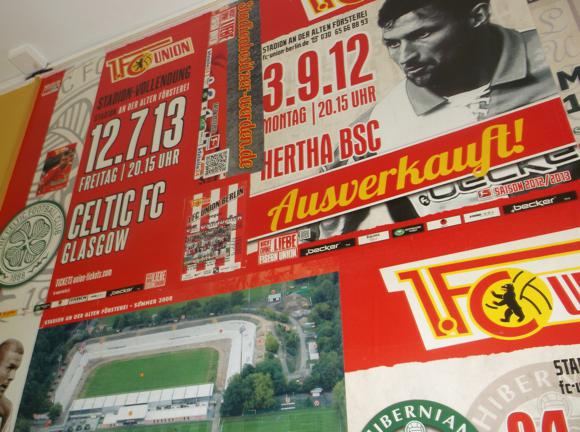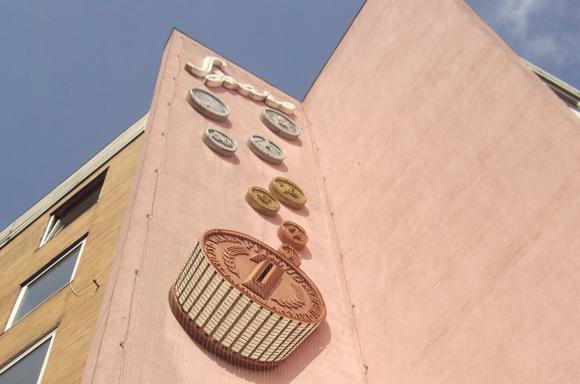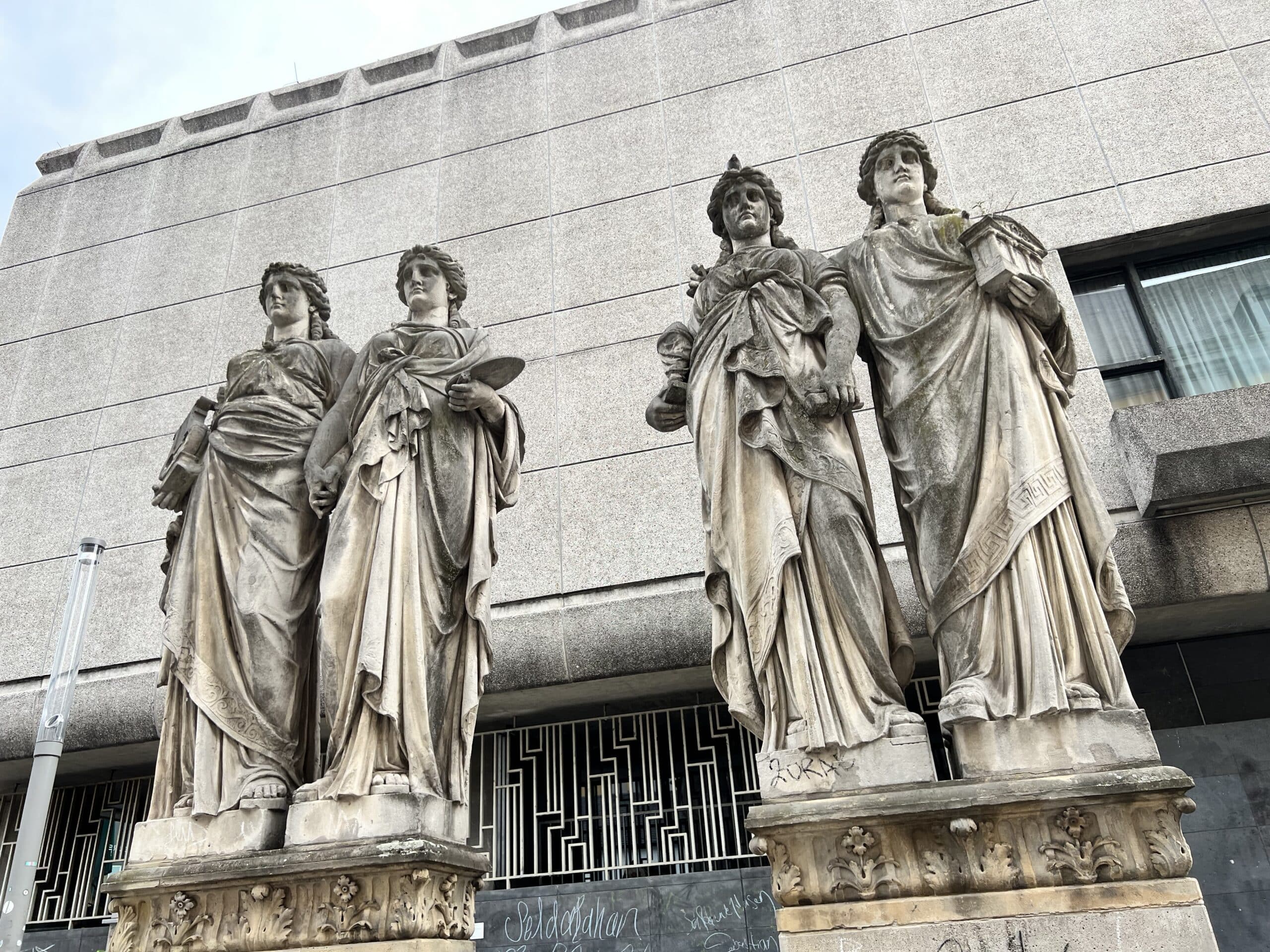Teams, tales and tips – a guide to the local game
Germany’s capital is also a football one, centrepieced by a historic national stadium that hosted the final of Euro 2024. Regular tenants of the Olympiastadion, the city’s flagship club Hertha could, until relegation in 2023, pack this 74,000-capacity heritage arena for major Bundesliga games.
As Hertha mull over options to move out after current contractual obligations expire in 2025, the club still manages to attract crowds of 50,000 for second-tier football. Between these spectators and the pitch, however, is a running track. It may be done out in Hertha blue, but it hardly lends itself to accommodating a club of Hertha’s potential.
Perhaps worse, after decades of enjoying primary status in Germany’s capital, Hertha have recently been overshadowed by Union Berlin in the East. The ultimate put-down came in the autumn of 2023, when for their debut campaign in the Champions League, the former GDR also-rans moved fixtures from their modest 22,000-capacity ground, Stadion An der Alten Försterei in Köpenick, to a sold-out Olympiastadion. The visitors for the last game? Real Madrid.
Yet no amount of prestigious occasions – German Cup finals, the Champions League final of 2015, Germany’s international games – can offset the legacy of this national arena. Not only is the signature architecture in place today after two major rebuilds, this is still the stadium that Hitler built for his tainted 1936 Olympics.



The next major global sporting occasion seen here was an entirely different affair, in a rebuilt city that delineated the border between East and West. The 1974 World Cup kicked off here, Beckenbauer’s West Germany making heavy weather of a 1-0 win over Chile. The South Americans, who had qualified after the USSR withdrew for political reasons, were East Germany’s next opponents in a tournament full of undercover intrigue.
Berlin, a paranoid, divided city before Unification in 1990, would have been the perfect setting for the GDR’s following match – in which they beat West Germany – but that took place in Hamburg.
Munich staged the 1974 final but when it was Germany’s turn to host the World Cup again, in 2006, Berlin did the honours. Here Zinedine Zidane famously headbutted Marco Materazzi before Italy picked up a fourth World Cup.
Overlooked for Euro ’88 and 2020, the Hauptstadt got the nod for the final of Euro 2024, elevating Berlin alongside Paris, Madrid, Rome, Munich and London as cities where World Cups and European Championships have been won. Two other knock-out games and three group matches will also be played at the Olympiastadion in the summer of 2024.

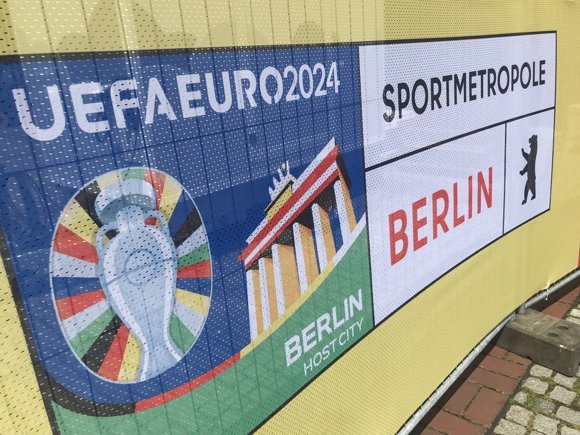

In footballing terms, the German capital was an early starter. Hertha can trace their history back to 1892. Pioneering clubs from Berlin won three national titles from 1905 to 1911. Twice national champions BFC Viktoria 1889 still exist more than a century later, although only after a merger with Lichterfelder FC in 2013. The name carved on the city’s annual knock-out Berlin Cup, most recently in 2024, is FC Viktoria 1899.
Though today based in Lichterfelde, south-west Berlin, Viktoria’s historic home is Tempelhof. Initially, they shared the recreational space of nearby Tempelhofer Feld with most of Berlin’s teams, including the original one, BFC Frankfurt 1885. Formed by later influential football administrator Georg Lux from Frankfurt, the boys in blue and white competed in the early Berlin championships of the 1890s, along with BFC Germania 1888, formed by the four Jestram brothers.
These leading teams were affiliated to separate associations in the imperial capital: the Deutscher Fußball und Cricket Bund, whose inaugural competition of 1891 was won by the expat XI of The English FC 1890, with Viktoria just behind; and the German-only Bund Deutscher Fußball Spieler, whose first title went to Germania.

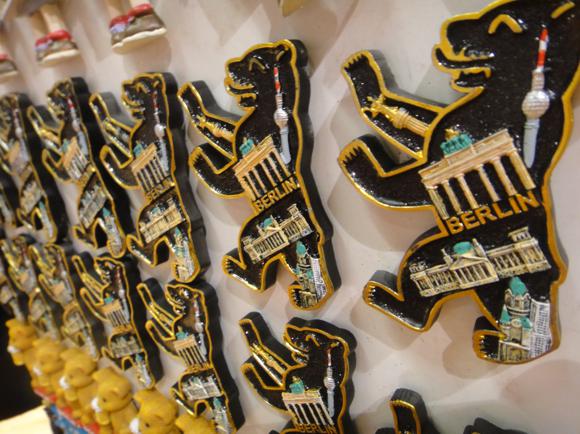

In 1892, Germania took on The English FC for the crown of Berlin and, by dint of the city’s primary status, national champions. Germania won 3-1. Again, matches were played at the Tempelhofer Feld, where the namesake airport was sited after 1923. Viktoria continued to compete in, and win, the DFuCB league through the 1890s.
In 1897, the Verband Deutscher Ballspielvereine (VDB) usurped the DFuCB, the insertion of ‘German’ in the name designed to improve standards and encourage teams from other cities to join. Viktoria soon jumped ship – but no clubs from outside Berlin. The organisation duly became the Berlin Football Association.
By the late 1890s, Hamburg and Leipzig had their own leagues. When the German Football Association (DFB) was formed in Leipzig in 1900, however, with 86 clubs as its founder members, more than a quarter of them were from Berlin. These included a new force in the German game, BFC Preußen 1894.

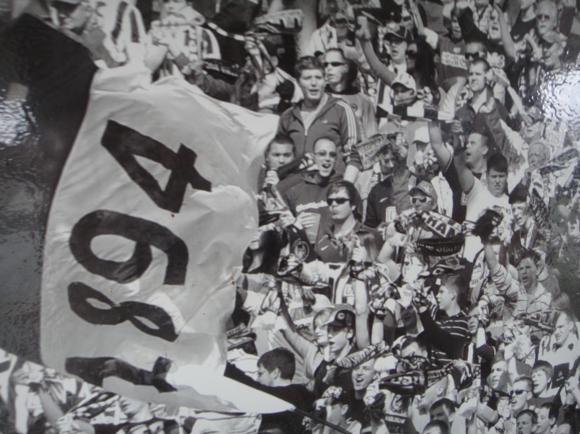

Originally called BFC Friedrich Wilhelm by pupils from the school named after the crown prince, son of the Kaiser and a passionate football man, the team adopted the short passing game learned from Britain.
Before changing its name to ‘Prussia’, it had been formed at the Dustren Keller tavern at Bergmannstraße 107. The city’s rebranded football association, the Verband Deutscher Ballspielvereine (VDB), convened at the same location for its own foundation three years later.
The pub was more than just a meeting place. Close to Tempelhofer Feld, it was also used as a changing room and a storage space. In 2014, a plaque was unveiled at the Bergmannstraße site in Kreuzberg by the Sport Kultur initiative set up by the Berlin Football Association. This is now one of 40 landmarks that form the Fußball Route Berlin launched the following year, three cycle tours of the city’s soccer history.
The main reason for the establishment of the DFB was to assimilate the myriad city and regional leagues now springing up around Germany – and across Berlin. The one whose champions the DFB chose to represent the capital in the national finals was the VDB.


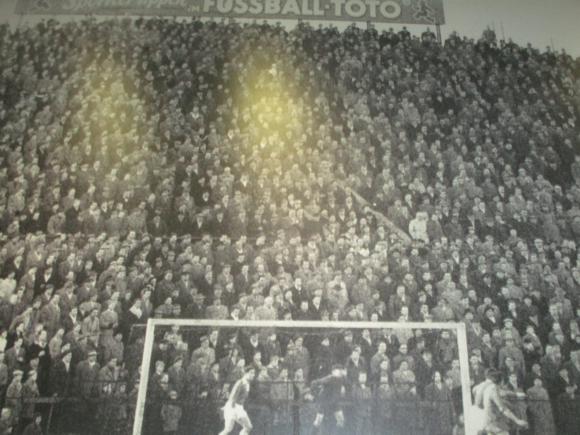
But these first representatives were neither FC Preußen, nor Viktoria nor Germania – but the distinctly British Britannia 1892. Attracting Berlin’s leading expat players, Britannia took part in the inaugural national German Championships in 1903, won by VfB Leipzig, and made the final against the holders in 1904. The match was never played due to protests from beaten semi-finalists Karlsruhe.
In Britannia’s ranks was forward Edwin Dutton, whose father Thomas is credited with bringing football and cricket to Berlin and Breslau, today Wrocław in modern-day Poland. Edward may have been born in nearby Międzylesie, back then Mittelwalde – although it might also have been South Shields. By the time he was of school age, however, he was in Berlin.
Dutton junior helped propagate the successful short-passing game, which is probably why he moved to BFC Preußen in 1903. Shortly after his solitary international for Germany in 1909, a 3-3 draw with Hungary in Budapest, Dutton was taken on by Newcastle United. By the time World War I broke out, he had returned to Britannia Berlin before opening a sports outfitters.
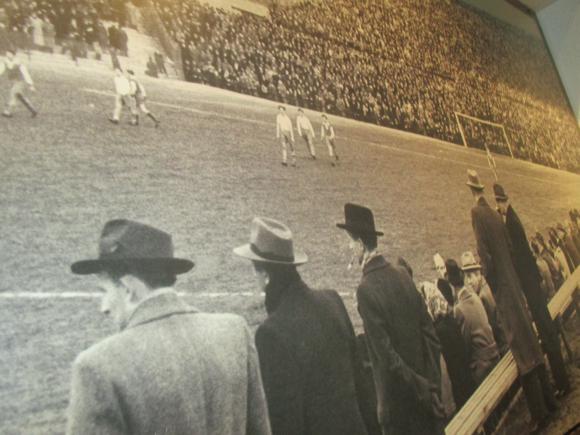


Dutton would be one of several prominent English players who formed teams while being interned at Ruhleben in Berlin Spandau, along with the great Steve Bloomer, coach at Britannia in 1914. The story of how the prisoners survived and kept their sanity in appalling conditions thanks to football is told in Paul Brown’s excellent book, The Ruhleben Football Association.
Back in turn-of-the-century Berlin, another team at the forefront was Union 92, which had welcomed key players from BFC Frankfurt 1885 after their club disappeared in 1900. Winning Berlin’s main league (now going by the acronym VBB to put the focus on ‘Berlin’) in 1905, ahead of previous winners Preußen, Viktoria and Britannia, Union went on to become the city’s first national champions that year.
Hero of the quarter-final win over Braunschweig was goalkeeper Paul Eichelmann, who had started his career at Germania. Despite the support of football-mad Crown Prince Wilhelm, the first German monarch to attend a football match, a showcase friendly he had arranged between Germania and Civil Service London at Tempelhofer Feld in 1905, the first all-Berlin champions had slipped down the pecking order.
The promising young keeper was happily snapped up by Union 92. Eichelmann also represented Berlin XIs against their Viennese counterparts and kept goal in Germany’s earliest internationals, invariably heavy defeats to England’s amateur and FA XIs.



The first of these came on November 23, 1899, at the Sportpark Kurfürstendamm, which had opened in 1897 where Droysenstraße meets Sybelstraße, behind Charlottenburg’s S-Bahn station. A Berlin selection, mainly featuring players from Germania, Britannia and Viktoria, lost 2-13 to an FA XI, whose top scorer Edgar Chadwick had won the league title with Everton that same decade, and would appear in three FA Cup finals either side of this seminal fixture.
Though neither FAs regard the game as official, records show that Walter Jestram, one of the four brothers who had founded Germania a decade earlier, scored one of the German goals. The same source also gives the hosts’ right-back as being Richard Gasse of Fortuna Berlin, only 14 at the time. This was literally men against boys. At 10am the next day, the two teams met again at the same ground, the result another pasting, 2-10.
it should also be noted that the pitch was the first proper one seen in Berlin, with markings according to the standard guidelines now being followed across Europe. It was the handiwork of Scot Andrew PItcairn-Knowles, a master of early photography, whose works are kept at the V&A in London and command steep prices at auctions.
For his lesser-known creation, the later health enthusiast had placed the pitch within an athletics ground, fenced it off, built a stand and charged admission. A crowd of 1,500 for the first game was considered substantial for the time.



Pitcairn-Knowles was co-founder of the pioneering illustrated monthly Sport im Bild, with a fellow expat Brit. Its aim was to show Germany to be ‘on an equal footing with our role models, England and America, when it comes to the execution of all sports’. It proved a great success, and by the time the men sold it in 1904, the magazine had gone weekly, with a circulation approaching six figures.
The pitch at Athletik-Sportplatz remained in place for BFC Preußen to use – with PItcairn-Knowles pocketing the admission money to finance his many projects. Preußen would play showcase international fixtures here, including the 8-3 win over Surrey Wanderers in 1901, the first time a German team had beaten one from England. The sports ground closed in 1903 as elegant apartment blocks were being built on what became Berlin’s showcase avenue of style, the Ku’damm.
The British connection remained strong until 1914. When the Berlin squad was invited to play two games in England in 1901, at White Hart Lane and Manchester’s Hyde Road, the sympathetic Eichelmann proudly came home with a ball signed by the hosts, who had racked up 12-0 and 10-0 wins against his teammates.
In 1908, Eichelmann was selected to represent Germany to face England Amateurs in Berlin. This was closer to a full international, at least according to German records, and the hosts included players from Hamburg, Dresden and Karlsruhe. Key members of the visiting team would go on to win Olympic gold by an aggregate score of 18-1 in London later that year.



In front of 6,000 spectators, Germany kept England to 1-5. The venue is also significant. Viktoria, now dominating Berlin’s VBB League, had outgrown Tempelhofer Feld. In 1905, they opened their own ground, Viktoria-Platz, in nearby Mariendorf, which is where this first semi-official meeting between football’s great foes took place. Standing on Eisenacher Straße until 1945, it’s another signposted stop on the Fußball Route Berlin tour.
After the war, the glory days of two national titles in 1908 and 1911 long gone, Viktoria quietly moved into the Friedrich-Ebert-Stadion in Tempelhof before the 2013 merger with Lichterfelder. A modest athletics ground, today it plays host to SD Croatia Berlin, one of a myriad ethnic or long-rooted clubs who compete every year in the Berliner Landespokal, arguably the most colourful cup of its kind in Europe.
Introduced in 1907, its first three editions won by Viktoria, the Berlin Cup is where you find the modern-day descendants of those pioneering clubs from the early 1900s. There is also an FK Srbija Berlin, a Bosna Berlin and a Polonia Berlin.
Most finals take place at the Friedrich-Ludwig-Jahn Sportpark, once the home of the dominant side in East Germany in the 1960s, Vorwärts Berlin. The various East German international games staged here are commemorated in the nearby Zur Insel bar, on Eberswalder Straße, close to the U-Bahn station of the same name.
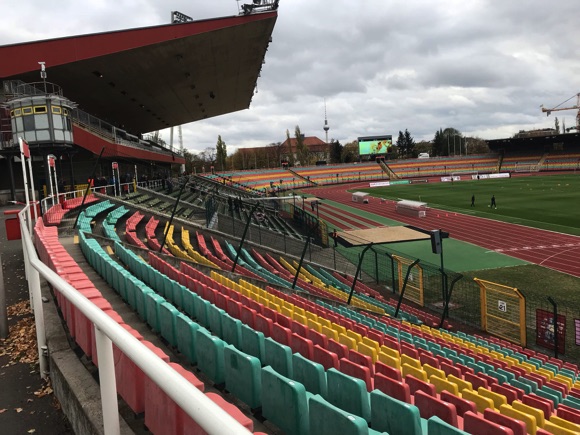


Any number of clubs have used the F-L-J since because their own ground was unsuitable for a higher level of football or being rebuilt. The most recent tenants have been VSG Altglienicke, Berlin Cup winners in 2020.
The sundry slackers and wastrels who passed through Berlin in the 1980s might still look out for the results of Blau-Weiß, the successor club to the populist one that folded in 1992, itself with direct links to venerable Union 92. Their stomping ground is still Mariendorf/Tempelhof, on Rathausstraße.
BFC Preußen won the trophy in 2016 – three years later, 1990 World Cup winner Thomas Häßler took over as coach. A Berliner through and through, ‘Icke’ reluctantly bowed out in 2022 for health reasons, but remains involved as an advisor. The club has its own ground, and sports bar, at Maltesersraße 24-36.
It’s a short stroll from Lankwitz S-Bahn station, also handy for Stadion Lichterfelde (Ostpreußendamm 3-17), where the modern iteration of Viktoria now play.
This is at least one level above the likes of Blau-Weiß and BFC Preußen. The Regionalliga Nordost reflects the Berlin’s patchwork football history in a wider context. Division four for Germany’s north-east region – effectively former East Germany plus West Berlin – is where you’ll now find Berliner FC Dynamo. The former GDR superpower missed out on promotion in 2022 by the odd goal in five over a two-leg play-off.


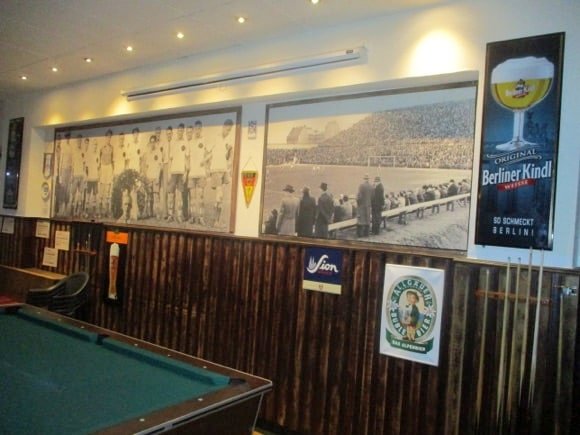
Divisional rivals until 2024, Berliner AK 07 play at the venerable Poststadion, walking distance from the city’s central train station, Berlin Hauptbahnhof. The de facto national stadium for certain periods between the wars, the Poststadion has a strange footnote in soccer history as being the only ground where Adolf Hitler watched a football match. Sharing hosting duties with the Olympiastadion for the 1936 Games, this former postal workers’ sports club was where 55,000 gathered to watch dark horses Norway beat Germany 2-0 before going on to win bronze.
One more name in the Regionalliga Nordost still keeps statisticians busy in the city’s football weekly Fußball-Woche. Former DDR-Liga stalwarts SV Babelsberg 03 are based at the Karl-Liebknecht-Stadion (‘Karli’) in Potsdam-Babelsberg, on the S7 line at Babelsberg, 30mins direct from Berlin Zoo.
‘Nulldrei’ overcame near bankruptcy in 2003 to put in a serious challenge for promotion to the second tier in the spring of 2013. Sadly, relegation to the fourth then followed. The club is also known for its fan culture, the Filmstadt Inferno 99 ultras linked to fellow lefty libertarians St Pauli.
Two other stadiums were used for the 1936 football tournament. One was Stadion am Gesundbrunnen, home of Hertha from 1924. Germany’s champions of 1930 and 1931 were based in the working-class district of Wedding, around which the Berlin Wall would be erected in 1961. It was here that residents jumped from their windows to avoid being stuck on the wrong side.


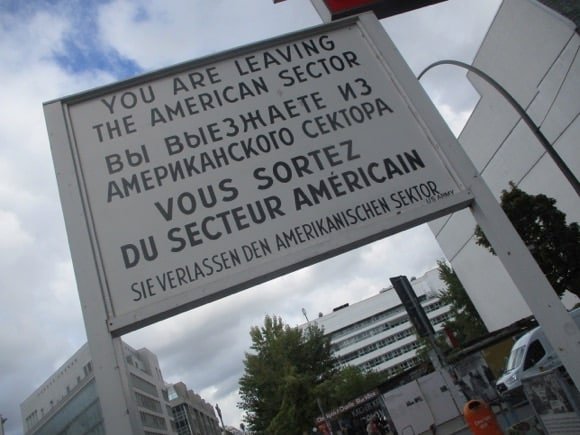
In the immediate post-war Berlin of Allied and Soviet sectors, Hertha were forbidden to play teams from what would become East Germany. These formed the Oberliga Berlin, and then the new DDR-Liga in 1950-51.
Hertha’s city rivals were therefore Tennis Borussia Berlin. Once the city’s second or third club, the Violets are based at the Mommsenstadion in Berlin-Westend, another 1936 venue. Pre-war managers back then included later national team coaches Otto Nerz and Sepp Herberger.
For 2023-24, TeBe moved out to Stadion Rehberge near former Tegel airport while ‘Mommse’ was being rebuilt. Austria selected the Mommsenstadion as their training ground for Euro 2024 – just as Germany used it to prepare for their own World Cup in 2006.
Hertha moved into the Olympiastadion as one of the founding members of the new national West German league, the Bundesliga, in 1963. It was later discovered that Hertha had offered players undercover payments to attract them to the then divided city. The West German FA, keen to keep West Berlin in the football family, later made a point of hosting the national cup final and international matches here.

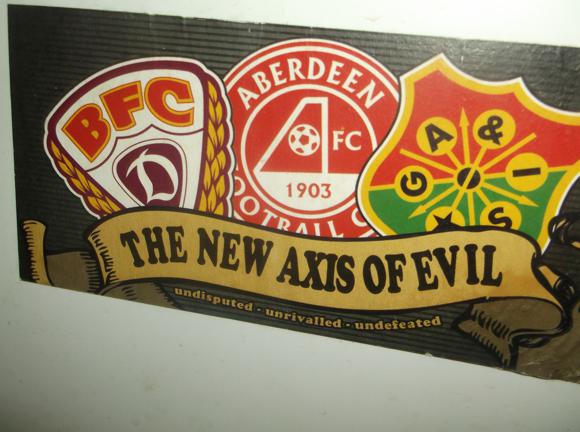

Over in the East, BFC Dynamo Berlin came under the dubious patronage of the Erich Mielke, head of the hated secret police, or Stasi. Mielke put pressure on referees to favour the flagship side from the East German capital. The so-called Schiebemeister, the cheating champions, won the GDR title for ten consecutive seasons in the 1980s.
Not even a genuine local working-class club, Union Berlin, could match them. In 1972, Dynamo made the semi-finals of the European Cup Winners’ Cup, losing to Dynamo Moscow – a case of the Stasi versus the KGB. Union, meanwhile, have long eclipsed Dynamo to become Berlin’s de facto second club, even outshining Hertha.
Union’s surprise European appearance in 2021-22 was followed by by beating Ajax in the Europa League of 2022-23. Then came a fourth-place finish in the Bundesliga, and Champions League qualification. In the autumn of 2023, none other than Real Madrid lined up against the red shirts of Union – the setting being a full house at the Olympiastadion.



Home is otherwise the modest Stadion An der Alten Försterei in Köpenick, where Ajax came to grief in 2023. Despite near relegation in 2024 – a late penalty at home to Freiburg hit the post, only for the rebound to save Union from the drop – this community club is a rare success story from Germany’s former East.
After 1989, the local football scene became a mix of discredited (often later reformed and/or renamed) clubs from the former East and teams that reflected Berlin’s status as the world’s fifth largest Turkish city. The most renowned has been Türkiyemspor Berlin, formed in the Turkish-influenced district of Kreuzberg, who play at Willy-Kressmann-Stadion by Viktoriapark.
Their achievements should not be judged in terms of league points and silverware – or by the fact that the club is now in the seventh flight. Promotion of Turkish and fellow local minorities has led to other Türkiyemspors being formed across Germany.
Getting Around
Arriving in town and local transport





The main city airport, Berlin Brandenburg, lies in Schönefeld, 18km (11 miles) south of town. At level U2 of Terminal 1, also easily reached from Terminal 2, BER Airport station connects with Berlin Hauptbahnhof, the main station in the city centre. The Airport Express service FEX, regional lines, S-Bahn line S9 and Intercity trains make the 30-minute journey into town every 10-15mins.
From Flughafen BER, as the airport rail terminal is given on timetables, a single journey to S&U Berlin Hauptbahnhof is €4.40, tickets sold from machines on the concourse above platform level. Don’t forget to validate yours by using the stampers around the concourse and platforms.
Note that S-Bahn S9 also runs directly to Olympiastadion, a journey of 1hr 10mins, slightly slower but more convenient than changing in town.
Berlin’s transport system of U-Bahn, S-Bahn and buses is divided into zones A, B and C, zone A the city centre. From the airport, a 24-hour pass (Berlin Tarifgebiet A-B-C, €11.40) and 7-day pass (VBB-Umweltkarte, €49) are also available.



Within the city, a standard single (Einzelfahrschein) is €3.50, a short hop (Kurzstrecke) of 3 stops (6 by tram/bus) is €2.40 and a day pass (24-Studen-Karte) for Zones A-B €9.90. Machines are found on platforms – again, validate in the little stampers you’ll see alongside. Ticket checks are not unknown and the fines draconian.
You can also download the Berlin transport app Jelbi for tickets and information.
Berlin Hauptbahnhof is on four main S-Bahn lines linking with the main points of Hackescher Markt and Alexanderplatz to the east, Zoologischer Garten and Olympiastadion (S3/S9) to the west. For Euro 2024, the Fan Mile runs from the Siegessäule victory column through the Tiergarten to the Brandenburg Gate, a 10-15min walk from the main station.
At the airport, the taxi rank is located outside Terminal 1 at level E0. Depending on traffic and final destination, the journey into town should cost around €45-€50. Berlin Airport Taxis suggest a fee of €49 with no nighttime surcharges.
TaxiBerlin24.de (+49 163 717 3833) is as good as any in town and accepts credit cards.
Where to Drink
The best pubs and bars for football fans

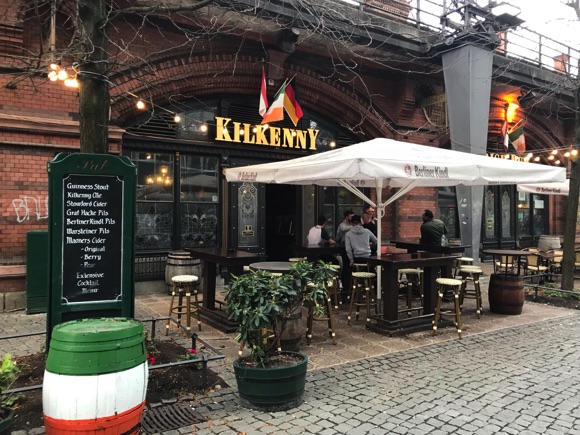
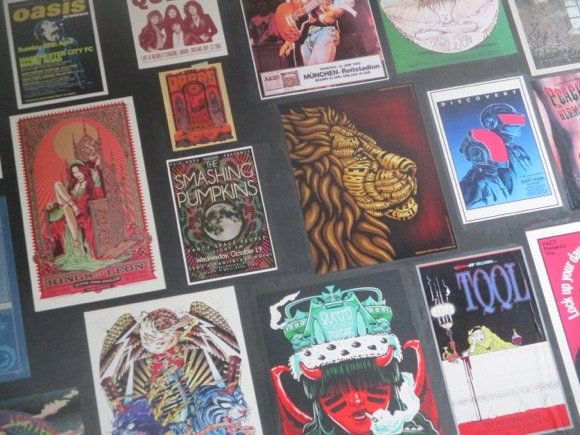





With 24-hour drinking and a bar on every corner, there’s no better city in Europe to push the boat out. The classic venue is the Eckkneipe, an age-old local hostelry, but you’ll also find trendy lounge bars, pubs serving Berlin’s significant expat community and football-focused beer gardens. See here for a selection of the best.
Many first-time visitors flock to the revamped retail and nightlife hub of Hackescher Markt, where sport-friendly pub Kilkenny is built into the station building. The other side of the station, The Pub shares the same name as its Czech-chain cousins, with match action also in focus, though here the beer you can pour at your own table is Berliner Pilsner.
To explore the world of beer a little further, the nearby Biermeisterei by Lemke serves the many brews crafted by Oli Lemke over the last 25 years or so, after being one of the first to set up a successful business here, the initial, smaller Brauerei Lemke, under the rails at Hackescher Markt. His expansion into larger, shinier premises on Karl-Liebknecht-Straße coincided with a focus towards gastro post-Covid.
All these bars have terraces, handy if you just been battling with the crowds around Alexanderplatz next door.
A short walk north at Rosa-Luxemburg-Platz, Belushi’s is one of two in town and several around the world, hostel-attached sports bars open to all, attracting a younger clientele. This one spreads out over two floors and an outside terrace, the wall dedicated to music hinting at the live concert agenda here on Friday nights.








A short stroll along main Torstraße to Rosenthaler Platz brings you to Sportsbar Tor 133, where many screens tune into match action behind an unmistakeable flame-red façade. For something more original, further north up Brunnenstraße to the junction with Veteranenstraße, the long-established cult football hangout, the FC Magnet Bar, still draws soccer aficionados 25 years after starting out as an outpost for homesick Mönchengladbach fans.
Some of its savvy urban regulars may remember the seminal exhibition, Netzer ’72, hosted here, others are involved in its pub team, granted decorative priority, although most of the focus is on the huge screen.
At the next junction over, you’ll find the Berlin Mitte branch of the BrewDog chain at Ackerstraße 29, promising big-screen Euro 2024 coverage to complement its regular 28 varieties of draught beer and pizza offers.
Where Invalidenstraße meets Nordbahnhof, The Castle is Berlin Mitte’s post-work, pub-by-rote hangout, though not too bad a pitstop if you’ve been sightseeing along the trail of the Berlin Wall nearby. It’s also an outlet for the city’s Hopscor Brewery, and shows games.







Just beyond Mitte is workaday Wedding, the district where the Boateng half-brothers grew up and the spiritual home of Hertha. Here, by the Berlin Wall, was die Plumpe, aka Stadion am Gesundbrunnen, the club’s ground until it was demolished in 1974, by which time they were playing top-flight fixtures at the Olympiastadion.
In its memory, slap opposite Gesunbrunnen S-Bahn station, the wonderful wood-panelled Bierbrunnen bar is shrine to the old ground and Hertha’s history, smokers in a glassed-off room puffing away beneath huge photos of Germany’s World-Cup winning line-ups. Authentic down to the retro Berliner Kindl ads.
Just the other side of the former stadium, the Offside Pub & Whisky Bar on Jülicher Straße specialises in the namesake spirit, with tastings scheduled, and TV football.
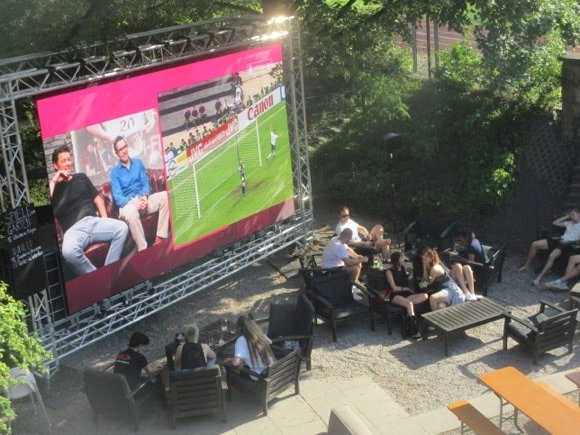








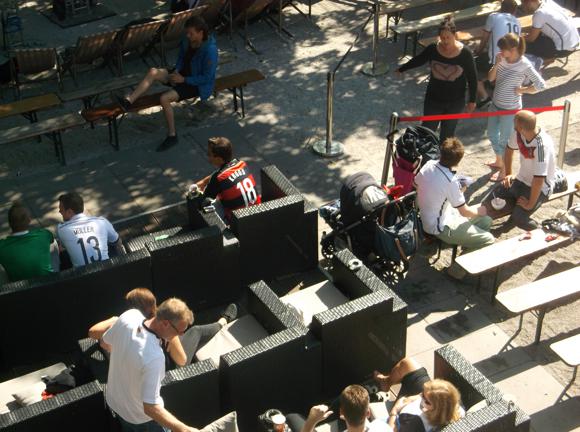




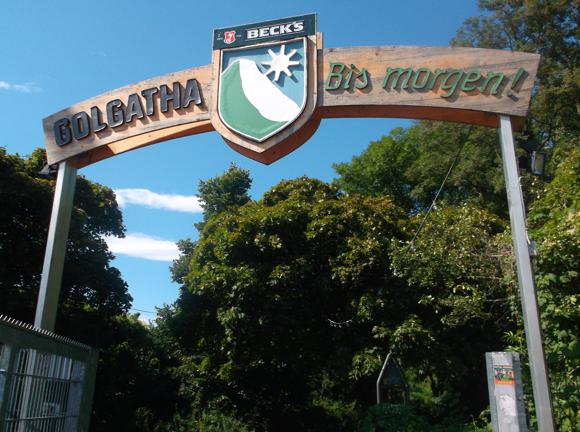
If you’re visiting Checkpoint Charlie, you might want to pop in for a pint at Murphy’s on Zimmerstraße, with big-screen sport and standard pub grub.
Following Friedrichstraße towards the Turkish quarter of Kreuzberg, you come to a more bohemian bar hub and the historic heartland of football in Berlin. At Mehringdamm 32-34, the pub-like Vogt’s Bier-Express has long screened matches to a local clientele, next door to a branch of Curry 36 if you hanker after a Currywurst while you’re watching.
For big-tournament summers, Berlin really can’t be beat. Outdoor bars, parks and beer gardens come into their own, such as Kreuzberg hangout Golgatha in Viktoriapark, with its huge screen like an open-air cinema.
Deeper into Kreuzberg, by Görlitzer Bahnhof U-Bahn, the low-key, late-opening Milchbar keeps barflies entertained with table football, pinball and live games on TV. Round the corner on Wiener Straße, music-focused Bar 11 is equally fussy about its football, with scarves on display along with horses’ heads, and matches shown. Alongside, age-old favourite Wiener Blut usually prioritises its DJ decks and jukebox over TV sport but raises its game for big tournaments and runs a pub team.
If you’re in the neighbourhood, don’t miss Ankerklause, a classic boat bar/restaurant with a vintage jukebox moored by Kottbusser Brücke.
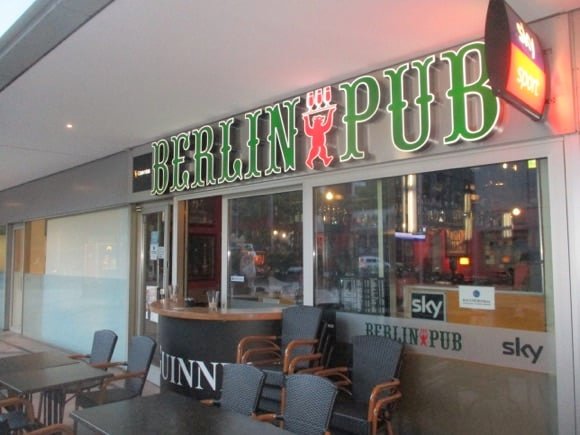















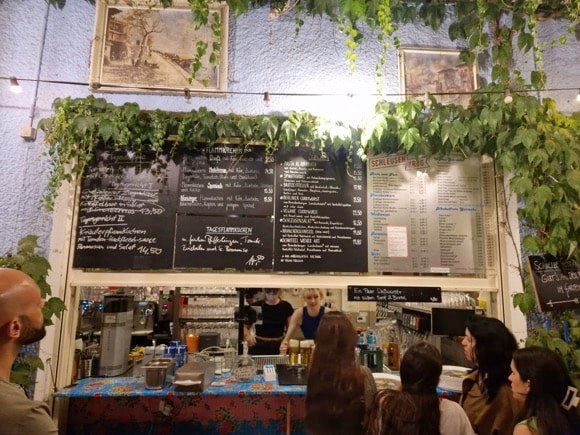
If you’re staying in the west end of town, around the retail hub around the Europa Center and Ku’damm, bars are more functional in feel, typified by the long-established Irish Pub hidden away in the shopping centre, with live music and sport regularly programmed.
You could also easily miss the Berlin Pub, on the other side of the building, but pop in if you can – it’s a locals’ bar overseen by the seen-it-all Mario, showing games and displaying original paintings of Berlin sights. This all feels very 1970s’ West Berlin. For a little food with your football, the Caffè Bistro Sport Italia alongside KaDeWe serves quality Italian dishes surrounded by calcio iconography – note the original Gazzetta dello Sport the day after the 1938 World Cup Final.
Even more local, with football at the forefront, is Puschel’s Pub a couple of U-Bahn stops away by Kurfürstenstraße station. Loyal regulars gather to watch games in a narrow space amid amusing, usually soccer-related, décor. It’s a friendly place to catch the match if an informal buzz if what you’re after.
At the edge of the Tiergarten, in operation since 1954, Schleusenkrug is where to go not to watch the match – at least for Euro 2024. Instead, it offers live music, quality Bratwurst and lesser-found Allgäuer Büble beer. In similar traditional vein, by Tiergarten S-Bahn station, Tiergarten-quelle sits under the rails, its leafy beer garden open from early April.
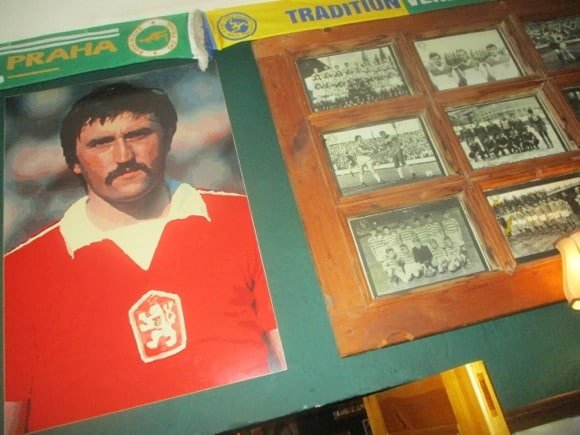







For those staying in the East, the best choice is a direct tram ride from Dynamo Berlin’s stadium on the M13 line. Another bar dedicated to the penalty pioneer with the droopy moustache, Panenka on Weichselstraße plays up its Ossi credentials by decking out its large, wooden interior with imagery of pre-89 football from this side of the Wall. You might spot a Union team line-up from the GDR Cup final or Jürgen Sparwasser’s goal from the East v West clash of 1974.
Many prefer to sit outside, plotting up on the long pavement table with their Czech Pilsner Urquell or the cheaper Beer of the Week. Note also the ‘Get Drunk for Lemmy’ sessions either side of Christmas.
Further east, closer to Dynamo, the Sportsbar Libero on Karl-Lade-Straße dedicates a whole wall to Germany’s World Cup moments, though regulars are just as happy to sit on the pavement terrace from mid-afternoon when it opens.
Where to stay
The best hotels for the stadiums and city centre







Visit Berlin has a hotel database with a booking function.
Of the lodgings near the Olympiastadion, one stop back to town diagonally opposite Heerstraße S-Bahn, bucolic Hotel Rotdorn is a 1920s’ villa set in greenery. Shared-bathroom singles/doubles are a steal, with apartments and bungalows also available.
Closer to the stadium near Pichelsberg S-Bahn, the Alecsa Hotel am Olympiastadion on Glockenturmstraße comprises mid-range rooms and dorms in a functional multi-storey building.
A short walk from Zoologischer Garten S-Bahn, the four-star Crowne Plaza Berlin City Centre Ku’damm caters to business visitors and those on city breaks with a conference centre, meeting rooms, spa and sauna.
Built into the Europa Center, the privately run, high-design Hotel Palace Berlin gazes over the city’s skyline from its upper rooms and Club Lounge. Other amenities include the House of Gin, beef 45 restaurant, and an impressive pool and sauna complex. Nearby, the four-star Mercure Wittenbergplatz is right alongside shopping mecca KaDaWe.

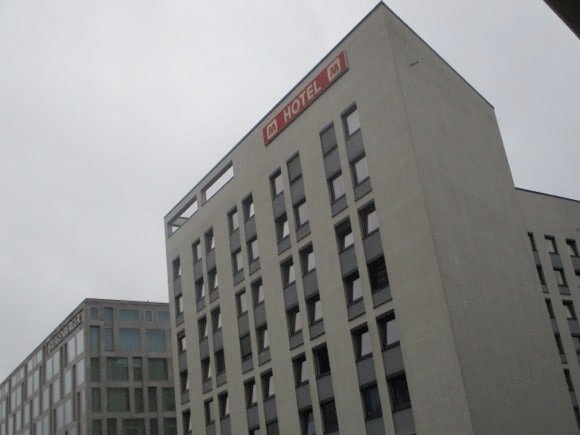



For the main station and Poststadion, Motel One Berlin-Hauptbahnhof is one of a handful of eminently affordable and stylish lodgings in town, in a chain expanding across Germany. Cheaper and closer to the stadium, the A&O Berlin Hauptbahnhof is part of another handy chain that offers hostel and hotel stays – at hostel prices.
Closer to Hauptbahnhof, on the other side of Europaplatz, the MEININGER Hotel Berlin Central Station offers en-suite singles and doubles, plus dorms, more than 800 beds in total, on eight floors. A games zone and children’s area should appeal if you’re travelling with the family.
Alongside, the Steigenberger Hotel am Kanzleramt has placed its expansive spa complex by the sky lounge, ensuring panoramic relaxation for a business-minded clientele. A location by the main station is a bonus, though its name is taken from the Federal Chancellery facing it.










Diagonally opposite the main station, the AMANO Grand Central shows Italian influence in its design and cuisine, its rooftop terrace ideal for private functions. Alongside, the Hotel ROMY by AMANO is its boutique sister, its kitchen and cocktail bar incongruously Mexican in influence. In between, the three-star ibis Berlin Hauptbahnhof couldn’t be more convenient, also facilitated by a noon check-out.
Further along Invalidenstraße, two chain hotels provide convenience and affordability: the Hotel Berlin Mitte by Campanile has a bar and 24-hour reception, while diagonally opposite, the Mercure Hotel Berlin City packs 246 mid-range rooms into this large corner building.
For the tourist-friendly hub of Hackescher Markt, the nearby Motel One on Dirckenstraße is not only handy, it’s stylish for the price.
The most famous hotel in town, the Adlon Kempinski was opened by the Kaiser himself in 1907. It somehow survived the war relatively unscathed but not the Cold War after it. Blown up by the GDR Politburo in the 1980s, the Adlon was rebuilt post-Unification to become the most exclusive address in all Germany. Its suites, ballroom and vast spa were renovated and added in the 2010s.
For its 125th birthday in 2022, Berliners were offered special rates to stay here, in the shadow of the Brandenburg Gate. Random nights, with an early-booking discount, can still be had for under €350. The lobby lounge welcomes smart-casual outsiders and those curious to see where spies, diplomats and cabaret singers mingled between the wars.
Where to shop
Finding cool football gear in the city

Right in retail central of Germany’s capital, the adidas Flagship Football Store Berlin pushes the boat during big tournaments with the latest collections and displays to die for. For Euro 2024, a quarter of the 24 teams dressed in adidas, including Italy, who never play in any old toot.
Note, also, Belgium’s Tintin-inspired second kit in sky blue and brown plus fours. Hungary, meanwhile went a little deeper where red was concerned. You’ll find the adidas Flagship Store (daily 10am-8pm) at Tauentzienstraße 15), across from the Europa-Center, a short walk from Wittenbergplatz U-Bahn.
For those whose tastes are a little more niche and obscure, Sascha Zapernick runs regular markets for secondhand football gear – old badges, shirts, scarves and pennants. The Berliner Sportfanartikel-Fanbörse either takes place within the office complex at Breitenbachstraße 10, near Eichborndamm S-Bahn station, which is where it is being held on September 7, 2024, or at the Trabennbahn Karlshorst, Treskowallee 129, near Karlshorst S-Bahn, which is where it is the following October 19.





